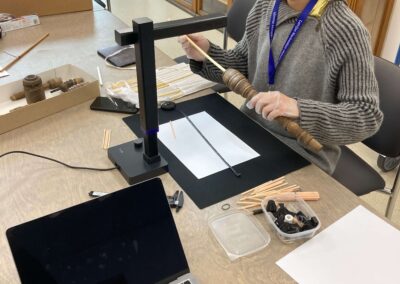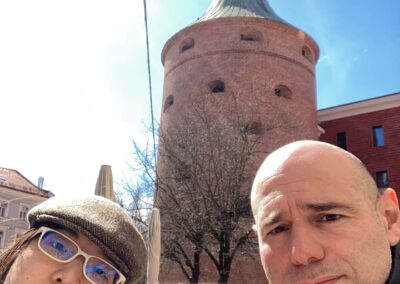My research on the bagpipes of the baltic would not be completed without a thorough understanding of the Duda phenomenon in Latvia.
With Zexuan Qiao (PhD.c) and Krishna Nagaraja (PhD.c) as research assistants, I had the opportunity to analyze, document and measure in detail 14 bagpipes stored at the National Museum in Riga.
We could not have been more well received. Historian and archive keeper Jānis Šabanovs, besides showing us the folk object collection, and providing full access to the bagpipes, even made contacts with other institutions in Riga to make sure that we were not missing out on measuring all the available Latvian bagpipes. Sure enough, there were two more instruments to measure in the Open Museum of Riga – Jānis set up a meeting for us. He also put us in phone contact with the foremost ethnomusicologist in Latvia – Valdis Muktupāvels, whom I met a few days after.
Special thanks to my supervisor prof. Kristiina Ilmonen and Prof. Ulrich Morgenstern that were instrumental in making this fieldwork trip a success.
What about the instruments?
The Latvian bagpipes in the museums are amongst the most beautiful and historically insightful instruments in the baltic sea region. In fact, I would state that Latvian Bagpipes are the most well-kept secret of the European bagpipe music scene.
If you don’t believe me, just make sure to stay tuned for the next couple of years, and see.










 Gonçalo Cruz
is a Researcher, Musician, Educator & Maker of Bagpipes & Woodwinds.
He holds a Masters in Architecture, and is currently a Doctoral candidate at the Sibelius Academy - “Forgotten Bagpipes - The redesign of the Säkkipilli in Finland”. His research interests are in the disciplines of Music, Ethnomusicology, Organology, as well as Art & Design, History & Archeology, with a special interest in the subjects of Instrument building, Tuning and Temperament.
As an artist, Gonçalo has been working as a music composer and guest musician on live and recorded performances, and is keen in developing the concept of “Music as Design”
Gonçalo Cruz
is a Researcher, Musician, Educator & Maker of Bagpipes & Woodwinds.
He holds a Masters in Architecture, and is currently a Doctoral candidate at the Sibelius Academy - “Forgotten Bagpipes - The redesign of the Säkkipilli in Finland”. His research interests are in the disciplines of Music, Ethnomusicology, Organology, as well as Art & Design, History & Archeology, with a special interest in the subjects of Instrument building, Tuning and Temperament.
As an artist, Gonçalo has been working as a music composer and guest musician on live and recorded performances, and is keen in developing the concept of “Music as Design”